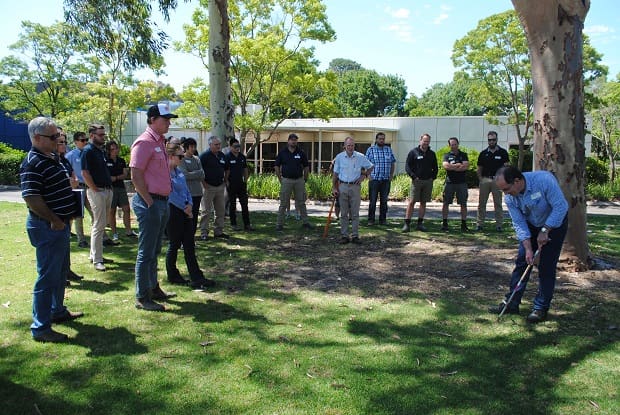
SARDI Soil Biology and Molecular Diagnostics group leader, Alan McKay, demonstrates the use of soil sampling probes for soil testing during a PREDICTA B Root Disease Risk Management Course for agronomists in Perth. (Photo: GRDC)
THE soil-borne fungi which cause Sclerotinia stem rot have been added to the suite of disease pathogens that can be identified by the PREDICTA B testing service.
Sclerotinia data generated from the testing service, in combination with other information, can help growers and agronomists determine the overall risk of being impacted by the disease in the coming cropping season.
PREDICTA B is a DNA-based soil testing service provided by the South Australian Research and Development Institute (SARDI) and can test for a comprehensive range of soil-borne pathogens.
SARDI Soil Biology and Molecular Diagnostics group leader, Alan McKay, said benefits of the test included identifying pathogens that posed a disease risk before crops were sown and identifying the need for long-term disease management.
“By using PREDICTA B, combined with advice from an accredited agronomist, disease pathogens can be detected and managed before losses occur from diseases such as Rhizoctonia, Fusarium crown rot and root lesion nematodes,” he said.
“PREDICTA B can now also test for the presence of S. sclerotiorum and S. minor, the two Sclerotinia pathogens most commonly found in Western Australia, although the test does not distinguish between the two species.”
WA Department of Primary Industries and Regional Development (DPIRD) plant pathologist Geoff Thomas said the development of Sclerotinia in crops was highly dependent on environmental conditions.
“The PREDICTA B test can add to the information growers have available to them about the risk of Sclerotinia developing in a specific paddock,” he said.
“Growers in high risk situations are advised to implement management strategies, which are available on the DPIRD website at http://bit.ly/2Quf2RW.”
To help assess risk factors for Sclerotinia, growers and their advisers should to assess the PREDICTA B results alongside information about risk factors including:
- Paddock history
- Rotation with susceptible crops
- Disease incidence in the last affected crop
- Distance from last affected crop
- Rain during flowering.
Mr Thomas said levels of root diseases such as Rhizoctonia root rot and crown rot were generally at ‘normal’ levels in WA in the 2018 cropping season, probably due to seasonal conditions, and this would maintain inoculum carried over into coming seasons.
Source: GRDC
For more information on PREDICTA B, including access to the soil testing service, go to http://bit.ly/2FyzZpE

HAVE YOUR SAY